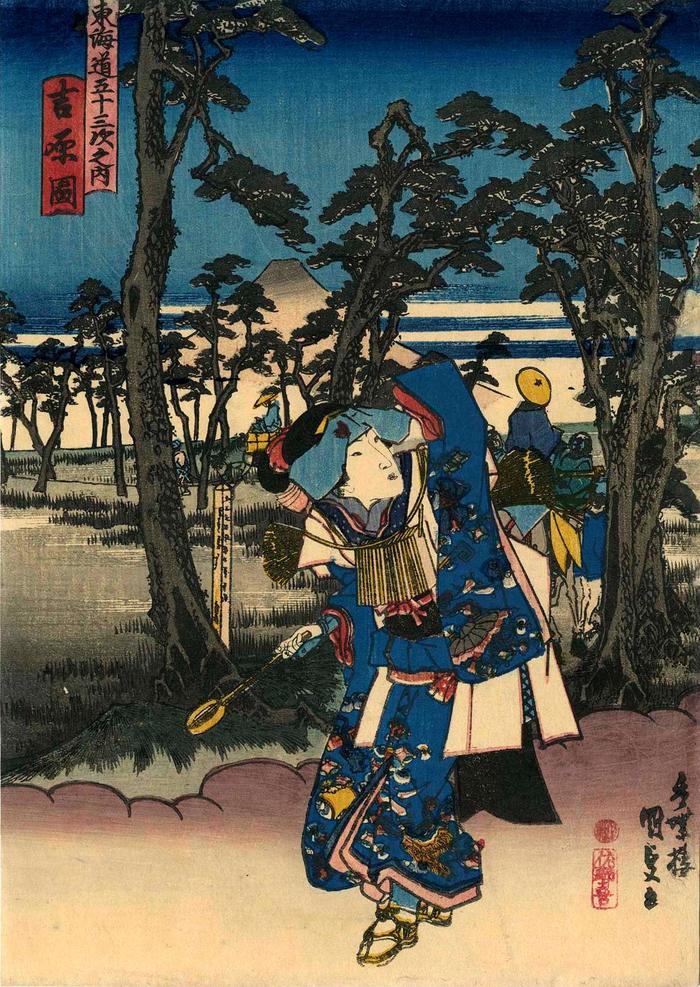Utagawa Kunisada (歌川国貞) / Toyokuni III (三代豊国) (artist 1786 – 01/12/1865)
View of Yoshiwara (Yoshiwara no zu: 吉原図) from the series Fifty-three Stations of the Tōkaidō Road (Tōkaidō gojūsan tsugi no uchi: 東海道五十三次之内)
ca 1838
Signed: Kōchōrō Kunisada (香蝶楼国貞)
Publisher: Sanoya Kihei
Censor's seal: kiwame
Museum of Fine Arts, Boston
National Diet Library
Museum für angewandte Kunst, Vienna
British Museum - Hiroshige's version 'Yoshiwara hidari Fuji'
Mt. Fuji and Princess Kagiya Museum
Ishikawa Prefectural Museum of Art - they date their copy to 1836
Bryn Mawr
Honolulu Museum of Art
The Spencer Museum of Art
Fujisawa Ukiyo-e Museum
Victoria and Albert Museum
Nelson-Atkins Museum of Art All the prints in this series are chūban sized. The example in the Museum of Fine Arts in Boston is 9 3/8 × 7 1/8 in. The print in the Lyon Collection is not quite as widel because it appears to be somewhat trimmed at the right side.
****
Yoshiwara is about 7 miles from Hara. The milestone marker is seen by the pine tree in the foreground on the left. The woman appears to be on a pilgrimage to various temples where she collects o-fuda (御札) or protective amulets to wear on a cord around her neck as proof of her journey.
****
This is the fifteenth print in this series. The curatorial files of Museum für angewandte Kunst in Vienna say: "The landscape depiction is again strongly based on Hiroshige's model. In the foreground is a woman in a dark blue kimono, which is decorated with various symbols of luck (invisible hat and coat, bag of luck and hammer, pearls, keys, ...)."
The title of the original Hiroshige print is 'Yoshiwara. Fuji on the Left' (Yoshiwara. Hidari no Fuji). Gian Carlo Calza in his description in Hiroshige: The Master of Nature of the original Hiroshige print re-imagined in this scene said: "The title of the print refers to the fact that Yoshiwara (not to be confused with the homonymous pleasure district in Edo) was the only place where one could see Mount Fuji to his left while heading south. Hiroshige depicts the road in this print with the curves that made this fact possible.
In the foreground under the pines, which form a sort of vaulted colonnade and create a sense of perspective, a guide leads a horse bearing three seated customers, a man astride and two women in seats on either side. The woman on the right has fallen asleep, while the other two are turned to the left to admire Mount Fuji. The undulating movement of the horse's tail seems to recall the curves in the road." Only the supposed sleeping woman is shown here with the man on the horse. The woman does not appear to be dozing. The other woman is hidden behind the Kunisada figure. Also, the horse's tail cannot be seen swishing.
****
In Tokaido Landscapes: The Path from Hiroshige to Contemporary Artists, 2011, #15, p. 27, speaking of the original Hiroshige print it says in a text by Sasaki Moritoshi: "Traveling the Tōkaidō through present-day Kanagawa and Shizuoka prefectures, Mount Fuji is most always on the right. In the few spots where the road turns north, Mount Fuji shifts over to the left. Such views are referred to as "left-hand Fuji," and one of the famous spots for such a view was just outside of the Yoshiwara station. The main characters in this print are the three children riding the horse; the child in the center and the one on the left are taking on the famous view. The child on the right, with drooping head, may be asleep, tired from the journey. Each is portrayed in an endearing pose and the depth of he perspective is remarkable."
In another section of Tokaido Landscapes: The Path from Hiroshige to Contemporary Artists is a section with prints by Munakata Shiko loosely inspired by the original Hiroshige Tōkaidō series. The artist also wrote the commentaries to accompany these prints. Of his Yoshiwara, Aki Fugaku ('Yoshiwara, Mount Fuji in Autumn) he wrote on page 77: "When we travel from Tokyo to Kyoto, Mount Fuji mostly appears on our right hand side. However, at one spot, we can see Fuji on our left. Hiroshige also depicted this view. Today there stands a paper factory, and I saw a magnificent pine tree. Mount Fuji, visible on the left, bears snow on its shoulder. It was evening and the air was filled with a calm, indescribable atmosphere. I added a couple and a child at the bottom as an accent."
****
Mt. Ashitaka (愛鷹山) appears on the right-hand side in the Hiroshige version, but not in that of Kunisada. However, this mountain does appear in other prints in the Kunisada series: the 14th which is the view of Hara and the view of Ejiri.
****
Illustrated in a small color reproduction in Kunisada's Tokaido: Riddles in Japanese Woodblock Prints by Andreas Marks, Hotei Publishing, 2013, page 65, T24-15.
Sanoya Kihei (佐野屋喜兵衛) (publisher)
landscape prints (fūkeiga 風景画) (genre)
beautiful woman picture (bijin-ga - 美人画) (genre)
